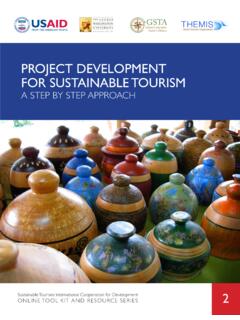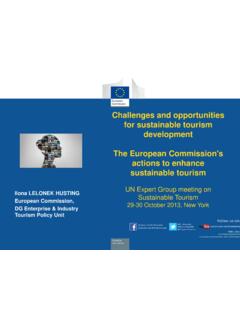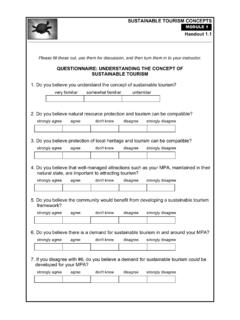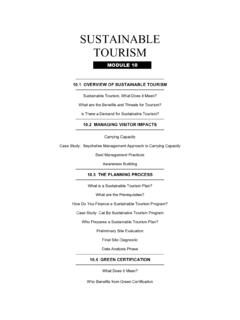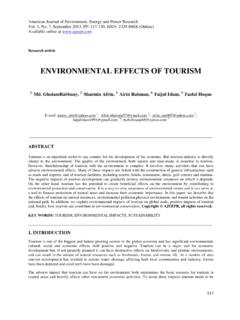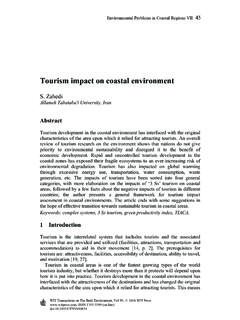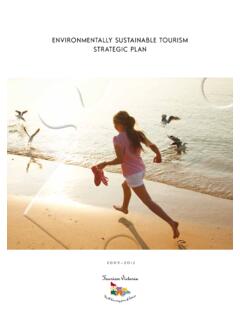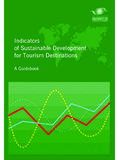Transcription of SEASONALITY IN THE TOURISM INDUSTRY
1 SEASONALITY IN THE TOURISM INDUSTRYI mpacts and Strategies Christine Lee, Sue Bergin-Seers, Graeme Galloway, Barry O'Mahony and Adela McMurray Impacts and Strategies ii Technical Reports The technical report series present data and its analysis, meta-studies and conceptual studies, and are considered to be of value to INDUSTRY , government and researchers. Unlike the sustainable TOURISM Cooperative Research Centre s Monograph series, these reports have not been subjected to an external peer review process. As such, the scientific accuracy and merit of the research reported here is the responsibility of the authors, who should be contacted for clarification of any content. Author contact details are at the back of this report. National Library of Australia Cataloguing in Publication Data SEASONALITY in TOURISM INDUSTRY : Impacts and Strategies Bibliography.
2 ISBN 9781920965518. 1. TOURISM - Seasonal variations - Australia. 2. TOURISM Australia - Management. 3. TOURISM - Australia. I. Cooperative Research Centre for sustainable TOURISM . II. Title. Copyright CRC for sustainable TOURISM Pty Ltd 2008 All rights reserved. Apart from fair dealing for the purposes of study, research, criticism or review as permitted under the Copyright Act, no part of this book may be reproduced by any process without written permission from the publisher. All enquiries should be directed to the STCRC Acknowledgements The sustainable TOURISM Cooperative Research Centre, established and supported under the Australian Government s Cooperative Research Centre s Program, funded this research. First published in Australia in 2008 by CRC for sustainable TOURISM Pty Ltd.
3 Printed in Australia (Gold Coast, Queensland). Cover designed by Sin Design. SEASONALITY IN THE TOURISM INDUSTRY iii CONTENTS ABSTRACT_____ V ACKNOWLEDGEMENTS _____ V SUMMARY _____ VI CHAPTER 1 INTRODUCTION _____ 1 CHAPTER 2 LITERATURE REVIEW _____ 2 INTRODUCTION_____ 2 INFLUENCING FACTORS_____ 2 CAUSES AND IMPACTS_____ 3 MANAGEMENT STRATEGIES_____ 6 CONCLUSION_____ 8 CHAPTER 3 MACRO PICTURE AUSTRALIA _____ 9 METHOD_____ 9 BROAD THEMES - THE TYPES OF STRATEGIES AND ISSUES THEY ADDRESS_____ 9 DIFFERENCES AND SIMILARITIES_____ 10 TRANSFERABILITY AND APPLICATION FOR A RANGE OF SETTINGS_____ 11 CHAPTER 4 MICRO PICTURE SELECTED CASES _____ 12 INTRODUCTION_____ 12 METHOD_____ 12 WINE TOURISM_____ 12 MOUNTAIN TOURISM_____ 13 CONCLUSION_____ 14 CHAPTER 5 CONCLUSION AND RECOMMENDATIONS_____ 15 CONSIDERATIONS_____ 15 THE FUTURE OF SEASONALITY NEW SOLUTIONS TO
4 OLD PROBLEMS_____ 16 APPENDIX A: SOURCES OF INFORMATION FOR DOCUMENT ANALYSIS _____ 17 APPENDIX B: STRATEGY: DIVERSIFIED ATTRACTION _____ 19 APPENDIX C: STRATEGY: MARKET DIVERSIFICATION _____ 21 APPENDIX D: STRATEGY: FACILITATION BY THE STATE _____ 23 REFERENCES _____ 25 AUTHORS_____ 26 Impacts and Strategies iv List of Figures Figure 1: Flow diagram of the structure and content of this report _____ 1 Figure 2: Factors of SEASONALITY in TOURISM _____ 3 List of Tables Table 1: Causes of seasonality_____ 4 Table 2: Impacts and implications of SEASONALITY _____ 5 Table 3: Strategies for addressing SEASONALITY impacts _____ 6 Table 4: Strategy: differential pricing _____ 9 SEASONALITY IN THE TOURISM INDUSTRY vABSTRACT SEASONALITY is a concept that is well studied and documented in the TOURISM literature.
5 Being ubiquitous, all TOURISM enterprises and regions are impacted by SEASONALITY whether severely or mildly. SEASONALITY causes the fluctuation in tourists and visitor numbers to a destination. Therefore, some destinations at certain times have more tourists and visitors than they are able to accommodate, while at other times, there are too few tourists and visitors to the region. Although, SEASONALITY is widely perceived in a negative light because its effects are linked with a reduction of tourist dollars, not all effects of TOURISM are negative. There are many strategies that are used to address the effects of SEASONALITY . These include pricing strategies, diversifying the attraction, market diversification and seeking assistance from the government and INDUSTRY bodies. Increasing the length of the tourist season and modifying the timing to school holidays are other strategies.
6 At enterprise level, additional strategies include the recruitment of temporary staff. With the range of available strategies for addressing the effects of SEASONALITY , the selection and adoption of a strategy should be in line with the strategic plan of the enterprise or the destination for an effective result. In today s environment, such decision making would need to include and consider social and environmental factors in addition to economic ones. Although many strategies can be transferable from one INDUSTRY to another, more detailed research is necessary to investigate the individual strategies in relation to the INDUSTRY and the impact of these strategies on the different stakeholders and the environment at the destination. ACKNOWLEDGEMENTS The sustainable TOURISM Cooperative Research Centre, an Australian Government initiative, funded this research.
7 Thanks are extended to the following individuals who have provided information on various aspects of this project: Regina Quaizon (Centre for Hospitality and TOURISM Research, Victoria University) Carl Jones ( TOURISM Victoria) Linda Brock ( TOURISM Coordinator, Latrobe City) Nicholas Hunt ( TOURISM Alliance, Victoria) Linton Smith (Adventure Victoria, Emerald, Victoria) Robin Shaw ( TOURISM Development Director, Winemakers Federation of Australia (WFA), Adelaide, South Australia) Jacqueline Blackwood (Information and Research Analyst, TOURISM Alliance, Victoria) Dr Richard Mitchell (Department of TOURISM , University of Otago, Dunedin, New Zealand) Simon Grant (Balgownie Estate Winery, Yarra Valley, Victoria). Ian Hollick (Managing Director, Hollick s Winery, Coonawarra, South Australia) Ron Camier (Mountain-Top Experience, Victoria) Michael Fozard (Manager, Old Gippstown, Gippsland s Heritage Park, Moe, Victoria) Tom Smith (Shipwreck Coast TOURISM , Great Ocean Road, Victoria) Linda Pearmine (Principal Planning Officer, Department of Education, Training and the Arts, Queensland) Justin Lalor (Events Development/Research Officer, Australian Capital Territory) Donna Shields (Information Resource Centre, TOURISM New South Wales) Keith Baker ( INDUSTRY Development Group, TOURISM New South Wales) Angela Collard (General Manager, Strategic and Business Development, Northern Territory TOURISM Commission) Mark Olsen ( INDUSTRY Development, TOURISM Queensland)
8 Michelle Hocking (Marketing Manager, South Australia TOURISM Commission) Sue Bell (Project Consultant, Destination Development, TOURISM Tasmania) Impacts and Strategies vi SUMMARY This report examines the concept of SEASONALITY , with a focus on Australia. SEASONALITY presents a number of issues that require special attention and strategies. In particular, SEASONALITY affects the number of tourists to a region and therefore can threaten the viability of businesses in a region. For example, SEASONALITY can place great pressure on remote or isolated TOURISM enterprises to staff their business with available and appropriate staff, far more so than for enterprises located in more populated areas. The outcome of the project provides a number of strategies to assist TOURISM agencies and enterprises in the management of TOURISM activity for improved economic and social returns.
9 In particular, this project provides a range of strategies that have been used at the destination and enterprise levels to ameliorate the effects of SEASONALITY . In addition, this project draws attention to other factors that need to be considered before any strategies can be adopted and applied successfully. Objectives of Study The key objectives of the study were to: Provide a general overview of SEASONALITY ; Identify strategies that may be useful for destinations and enterprises to manage the impact of SEASONALITY ; and Evaluate the usefulness and effectiveness of some of these strategies for remote regions in particular. Methodology Firstly, the academic literature was utilised to explain and evaluate the dimensions of SEASONALITY . A range of strategies, derived from the literature, were identified and selected for further study of the INDUSTRY .
10 In the next phase, the INDUSTRY documents comprising INDUSTRY reports and plans were evaluated for these strategies for use at a macro level. Following this, a number of semi-structured interviews were conducted with TOURISM stakeholders to determine the usefulness and use of these strategies at both the destination and enterprise levels. Key Findings There are many strategies that are used to address the effects of SEASONALITY . At both the destination and enterprise levels, there are several general strategies that are used, including: Pricing, such as seasonal price variation; pricing to attract a target market; Diversifying the attraction introduction of special events and development of incentives for a particular target market; Market diversification target different markets for different seasons; and Facilitation by the state (government or TOURISM agencies).

